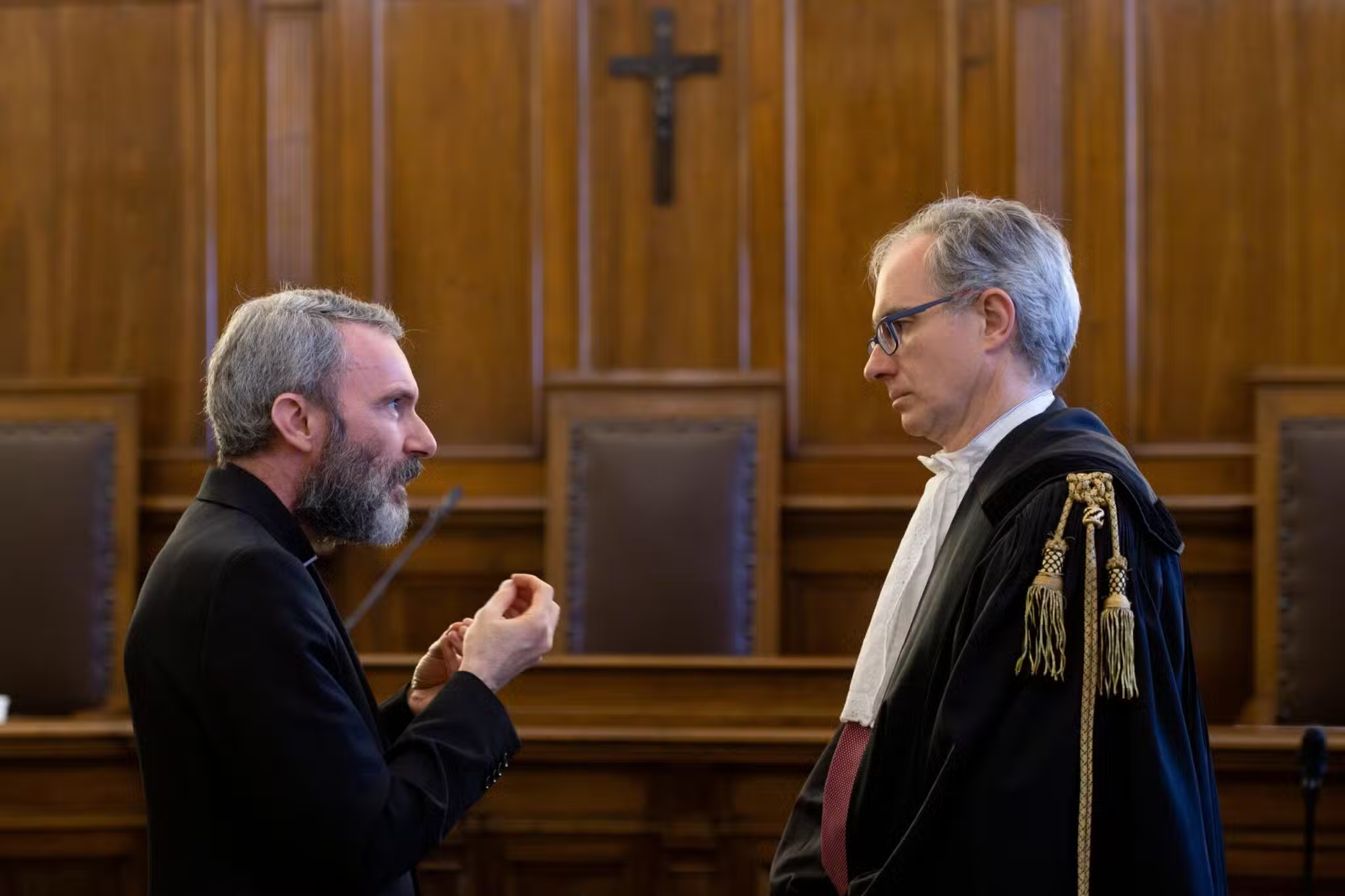On Ash Wednesday at St. Peter’s in the Loop in the heart of Chicago, 20,000 people will begin their Lenten journey.
On Ash Wednesday, Catholics show their stuff. It’s not the fancy jewelry you might see in a night on the town. It’s the ash of penitence, typically received at church, smudged onto our foreheads, faith on display as we walk about. In few places will you see a greater outpouring of public witness than at the Franciscans’ St. Peter’s Catholic Church in Chicago, known to the locals as “St. Peter’s in the Loop.”
Think we’re exaggerating? “We estimate that somewhere in the neighborhood of 20,000 people come through the doors,” says Kurt Hartrich, OFM, the pastor. The “we” he refers to are 17 friars who staff the church every day, hearing confessions and leading liturgies. “On Ash Wednesday,” says Father Kurt, “the lobby is absolutely chaotic.” At any given moment, four to six friars are distributing ashes in the downstairs auditorium, while 12 Masses (short ones!) are being celebrated throughout the day, and, he adds, “We hear confessions all day.” Ushers staff the doors, pointing people up or down the Minnesota-marble stairs.
The Loop is so much a part of Chicago’s identity that even the 26-ton marble crucifix towering over the church entrance is titled “Christ of the Loop.” For the unfamiliar, the Loop is the city’s core. An elevated commuter train track (the “L”) has encircled the downtown business district since the 1890s. Today it transports an estimated 74,000 commuters into, out of, and around the Loop each business day.
Decades back, when the friars were looking to move Old St. Peter’s from an abandoned neighborhood to a place in the heart of the city, they chose the site of a former movie theatre. The site, it turns out, is only a few blocks from the original St. Peter’s, founded in 1863, which had been literally rolled across town to serve the South Loop neighborhood and thrived there till the neighborhood declined.
“Technically, it’s not a parish,” says Father Kurt, unlike St. Peter’s previous location. It’s a service church, he says. One thinks of much smaller service churches, such as airport chapels and the like. St. Peter’s looks every bit the large downtown parish. Yet, “we have no official registered parishioners. We have no parish directory, and we don’t send out envelopes. The whole mission of this place was to serve the people who do not live downtown, but who did come into downtown all the time to work and shop.”
There are some regulars, though, more so as new, traditionally suburban populations move into the Loop. But those are the only visitors the friars come to know. Most of the traffic are people on the move downtown.
Maybe that’s why it’s such a popular location on Ash Wednesday. It’s everyone’s church.
Ash Wednesday Rush
“In some ways it’s like any other parish, except bigger,” explains Father Kurt, speaking of Ash Wednesday. And even with the multitude of priest and brother friars, some of the distributors are laypeople. “We don’t do it during Masses because there isn’t enough time,” he says, explaining the Masses are at 6, 6:45, and so on. Downstairs, ash distribution starts at 6 a.m. and goes for the next 13 hours, to accommodate everyone’s workday.
“Some people don’t go to Mass; they just go directly downstairs to get their ashes.” And some head for confession first. “So we have people in the lobby,” says Father Kurt, “three or four people throughout the whole day, to direct people according to what they really want. It’s like a soup market, a department store, or Target. You come in and want to get something, but you don’t know exactly where it is. You have greeters, you know,” he says, chuckling at the comparison.
Something about Ash Wednesday, about wearing a deep reminder of our own mortality, brings people in from everywhere. “Even though we don’t have time to ask people, like, ‘What is your background?’ I am sure many non-Catholics come.” And that’s fine with the Catholic Church. The ashes are a sacramental, a practice of the faithful that can happen anywhere, even in the home.
Some Churches, noticeably in the Protestant community, take ashes out into the community, at L stops and the like. But that doesn’t appeal to Father Kurt, who thinks like the pastor of any busy church: “Number one, we don’t have time.” His second reason has more to do with the way a community interacts at church. “It’s just like, you know, the Catholic Church basically says if you are going to get married, you are supposed to get married in a church, not on a beach type of thing.” Speaking as perhaps most pastors would, he sees the same on Ash Wednesday. His desire is that people come to the heart of the church to receive the sacramental ashes. “Sacramentals deserve a sacred space,” he says. “We wouldn’t do the L stop.”
With that in mind, St. Peter’s decorates the downstairs auditorium to give it a Lenten feel. “We also have music,” he says. “It could get to be rather raucous—well, not raucous, that’s too strong. But you get all kinds of people there, and they are waiting. They could be talking to other people. We ask people to please, when you come and are waiting for your ashes, to please be silent and reflective. It’s really quiet and respectful and sacred.”
Ash Wednesday Everywhere
What’s the fascination with ashes? “I think it’s a way of trying to reflect on the whole idea that we are not immortal,” says Father Kurt. “We are mortal. We are people who are at some point going to die and meet our maker. So it really does touch the heart of who we are.”
Then there’s the identity, or even the evangelization part. “Somebody might see the ashes and think, Oh, yeah, I’ve got to do that too,” observes Father Kurt. Catholics really aren’t as comfortable as some Christians about announcing their faith to strangers. Ash Wednesday cuts through that hesitancy: “It’s symbolic but it’s still very, very real that I am a Christian, I am not going to say Catholic, but I am a Christian, and this is the beginning of a period of penance. I want other people to know that I take this seriously. Once people get their ashes, they are more willing to have others notice it and they make a statement, so to speak.”
Standing and distributing ashes, hearing confessions, and celebrating Eucharist are real work. “It’s a very tiring day, oh boy,” Father Kurt admits. “I have to say, when the day is done, you do wonder what is the real effect,” he says, in a reflective moment. “You never know.” Will the penitents really focus for all of Lent and make the season one of renewal? Will people really follow the directive of Lent to pray and seek repentance for their sins? “Probably the answer is, if you could ask, some will and some won’t.” That’s the pastoral reality of anyone sharing the good news of our faith.
“I will say this,” Father Kurt offers. “It really is a humbling experience to just be part of this, to see so many people. You see some families and some very elderly people who have made their way downtown for whatever the reason, and come through. They are having a hard time walking even, but, by gosh, they are here.
Remember that you are dust, and to dust you shall return, is a reminder to wake up and pay attention.
“My hope is that by what they have done, no matter what their motivation might be, that somehow or another having come to get ashes, having come to St. Peter’s, they’ve been reminded of the importance that in the midst of a secular life we are also to work out our salvation. This is one way we do that.” He also hopes that the day is about more than ashes; it will be about persevering in a renewed participation in the life of the Church throughout all of Lent.
That’s the point of the newer formula for the distribution of ashes, “Repent and believe in the Gospel,” though even the older formula, “Remember that you are dust, and to dust you shall return,” is a reminder to wake up and pay attention.
Ministers distributing ashes have the option to use either one, explains Father Kurt. “A lot of the people will use both of them. They have hour-long shifts.” They switch formulas to make sure things don’t get too routine, he explains.
Every once in a while, he says, “If you’re using the one of ‘return to the Gospel,’ [a penitent] will say, ‘No, no. I want the one about dust.’ Then you do it.”
It’s all in a long day’s work.
Sidebar: Ashes around the World
In most countries, ashes are commonly the burnt remains of last year’s palms from Palm Sunday processions. In some parishes, you’ll see distributors pouring a small amount of ashes on the penitent’s head. But more frequently you’ll see the distributor dip his or her thumb in a dish of ashes and inscribe a cross on the forehead.
Did you know there are other customs worldwide? Some are for Ash Wednesday, others for the day before (Shrove Tuesday). In Iceland, for example, traditionally children pin small bags of ashes on the back of some unsuspecting person. Nowadays it’s more common for children to dress in costumes and sing for treats, much like our Halloween. Shrove Tuesday, also known as Pancake Tuesday or Fat Tuesday (Mardi Gras), marks a time when restricted food is finished off before the Lenten fast begins. In places that celebrate carnival, ending at midnight Tuesday, some penitents might show up the next day a bit hungover.
In Ashford, Derbyshire, England, there is the two-day, no-holds-barred Royal Shrovetide football (soccer) game among a large crowd on Tuesday and Ash Wednesday, the goal of which is to get the ball to one goal or the other at either end of the three-mile-wide town. In southern Germany, members of the money-laundering guild wash their money and wallets in a fountain at the conclusion of Shrove Tuesday, a sign of Lenten readiness. Filipinos gather on Ash Wednesday, after receiving ashes, to have their medals blessed by clergy.
Sidebar: Rules of Fasting and Abstinence
From the US Conference of Catholic Bishops:
Ash Wednesday and Good Friday are obligatory days of fasting and abstinence for Catholics. In addition, Fridays during Lent are obligatory days of abstinence.
For members of the Latin Catholic Church, the norms on fasting are obligatory from age 18 until age 59. When fasting, a person is permitted to eat one full meal, as well as two smaller meals that together are not equal to a full meal. The norms concerning abstinence from meat are binding upon members of the Latin Catholic Church from age 14 onward.
Members of the Eastern Catholic Churches are to observe the particular law of their own sui iuris Church.
An aside from the bishops: “Indulging in the lavish buffet at your favorite seafood place sort of misses the point.”
And another: “CRS Rice Bowl is one way Catholics can enhance their Lenten fasting practice by giving up meals and donating the cost of those meals to Catholic Relief Services, in order to help those who do not have enough to eat.”








